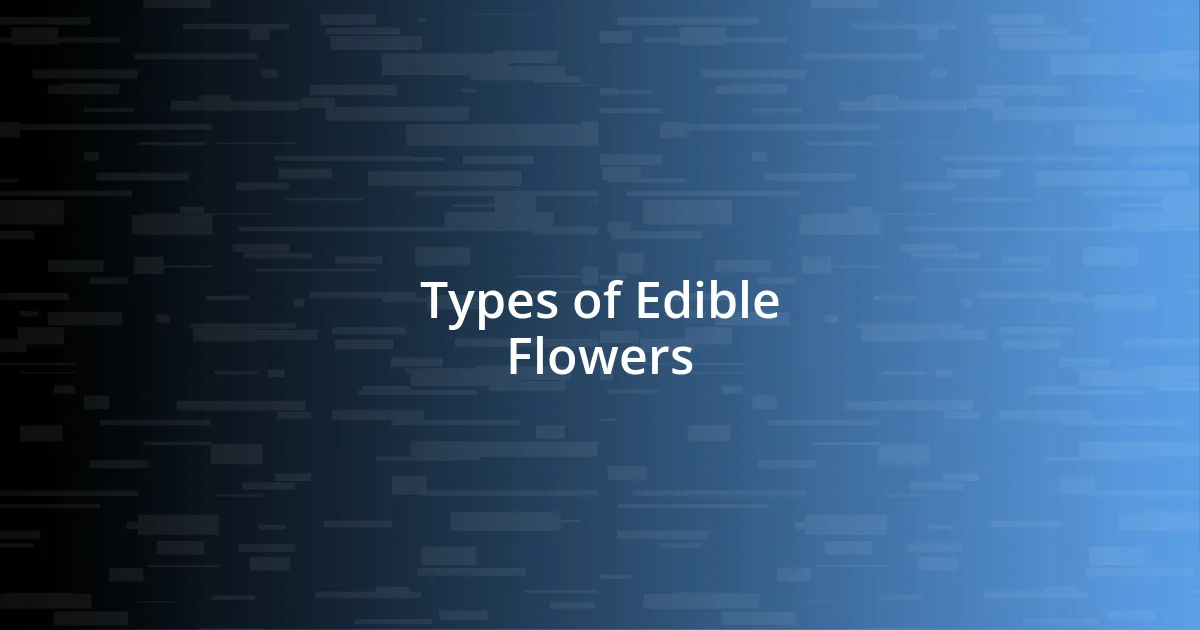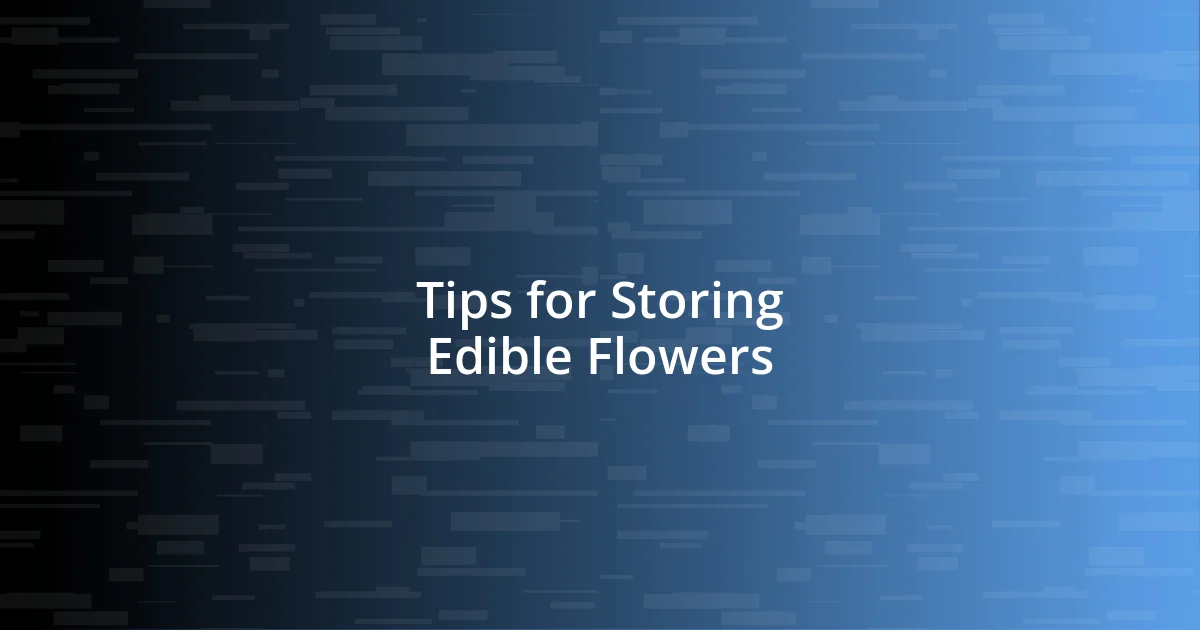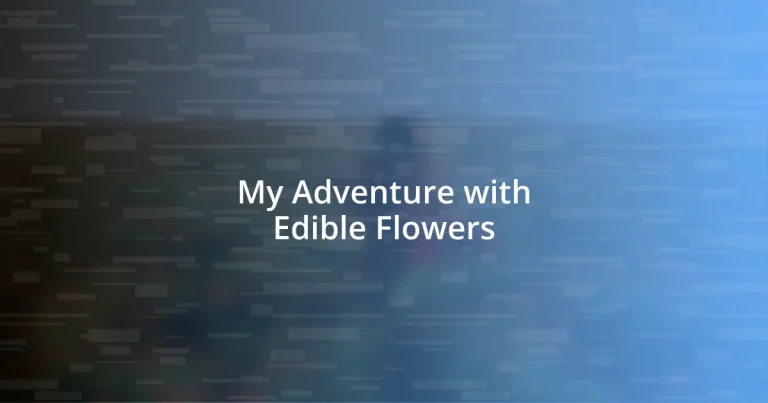Key takeaways:
- Edible flowers enhance meals both visually and flavor-wise, offering various unique tastes and aromas that can elevate culinary experiences.
- Safe harvesting techniques and proper storage methods, like refrigerating and freezing in ice cube trays, help maintain the freshness of edible flowers.
- Creative recipes, such as lavender-infused honey and hibiscus iced tea, showcase the versatility of edible flowers in everyday cooking and special occasions.

Introduction to Edible Flowers
Edible flowers have captivated my senses in ways I never expected. Just the sight of vibrant petals, from cheerful marigolds to delicate nasturtiums, can transform a simple dish into a visual masterpiece. Have you ever wondered how these tiny blooms can elevate your culinary experience?
When I first experimented with adding lavender to my desserts, I was pleasantly surprised. The subtle floral notes infused my lavender honey cookies with a unique flavor that was both refreshing and comforting. It made me consider: how many other edible flowers could unlock new dimensions in my cooking?
Exploring the world of edible flowers feels like a delightful adventure where nature’s beauty meets culinary creativity. Each flower tells a story, offering a range of flavors and aromas just waiting to be discovered. Wouldn’t you agree that incorporating such natural wonders into your meals can create a more wholesome connection to the food we eat?

Benefits of Edible Flowers
One of the most delightful benefits of using edible flowers is their ability to enhance the flavors of dishes in surprising ways. I recall a summer picnic where I added borage flowers to my lemonade. Their cucumber-like taste created a refreshingly unique twist I would never have thought possible. Besides their flavors, edible flowers are packed with nutrients, making them a great addition to a healthy diet.
Here are some benefits of incorporating edible flowers into your meals:
- Visual Appeal: They add vibrant colors, making dishes look more enticing.
- Flavor Variety: Each flower brings its distinct flavor, from sweet to spicy.
- Nutritional Boost: Many edible flowers are rich in vitamins and antioxidants.
- Aromas: They provide delightful scents that enhance the overall culinary experience.
- Culinary Creativity: Using them encourages experimentation and personal expression in cooking.
Ultimately, these blooms not only beautify your plate but also uplift the dining experience in ways that feel magical.

Types of Edible Flowers
Exploring the varieties of edible flowers is like discovering a rainbow of flavors and textures. For instance, I’ve grown particularly fond of nasturtiums. Their peppery taste adds a unique bite to salads, contrasting beautifully with the crispiness of fresh greens. It’s fascinating how a simple flower can completely change the flavor dynamics of a dish, don’t you think?
Then there are pansies and violets, which are among my absolute favorites for desserts. Their delicate sweetness is a perfect complement to creamy frostings. One time, I decorated a layer cake with them, and the guests were not just drawn to the vivid colors; they were captivated by the subtle hint of floral on their palate. It’s interesting how something visually beautiful can also excite the taste buds.
Furthermore, chamomile flowers have a calming effect that I cherish, especially in teas or infused syrups. I once hosted a cozy tea party where I used chamomile petals in my brew, creating an atmosphere that felt soothing and inviting. The guests felt relaxed, and I believe it was the ambiance created by those tiny flowers that played a big part in our delightful afternoon.
| Flower | Flavor Profile |
|---|---|
| Nasturtium | Peppery, akin to radishes |
| Pansy | Sweet, mild |
| Violet | Sweet with a touch of earthiness |
| Chamomile | Subtle, floral, soothing |

How to Harvest Edible Flowers
When it comes to harvesting edible flowers, timing is everything. I’ve found that early in the morning is the best time to pick them, just after the dew has evaporated. There’s something refreshing about those early hours—you feel connected to nature while the petals are still crisp and vibrant, ready to be enjoyed.
While gathering flowers, it’s crucial to gently twist or cut them from the stem rather than pulling. I remember an instance where I hastily yanked a few blooms, causing damage to the plant itself. It left me feeling a bit guilty; after all, those plants are my culinary allies, and I want them to thrive. By taking care during the harvest, I ensure that I can return to them time and again for more culinary adventures.
Don’t forget to check for pests before bringing the flowers into your kitchen. Once, I spotted a tiny caterpillar munching away, and instead of being annoyed, I found a strange joy in witnessing nature at work. After all, it’s their world too! Thoroughly rinsing your flowers helps remove any lingering bugs, making them safe and ready for your next delicious creation.

Cooking with Edible Flowers
Using edible flowers in cooking is a delightful way to elevate your dishes. I remember one evening when I decided to throw a little dinner party. I sprinkled some fresh nasturtium petals over a vibrant quinoa salad. The guests were initially curious; some even asked if they were safe to eat! That burst of peppery flavor surprised them and added an exciting twist—everyone was buzzing about it for days!
I also love adding violets to my homemade syrups. One summer, I came across a recipe while browsing my favorite culinary blog, and I had some violets in my garden. The process was almost therapeutic—infusing the delicate petals in sugar and water, watching their color transform the syrup into a beautiful lavender hue. When I drizzled it over pancakes, the aroma wafted through the kitchen, inviting my family to gather around. It’s amazing how such a simple addition can create cherished moments like that.
Let’s not overlook the versatility of chamomile. In a recent baking experiment, I infused the petals into butter for a batch of cookies. It felt a bit unconventional, but the end result was delightful. The soft, soothing flavor complemented the sweetness while adding a unique characteristic. I often wonder: have you ever tried incorporating unexpected ingredients into your cooking? Each time I do, it turns into an adventure, whisking me away to new culinary landscapes.

Creative Recipes for Edible Flowers
When it comes to edible flowers, one of my favorite creative recipes is lavender-infused honey. I remember harvesting fragrant lavender blooms on a warm afternoon, the scent wrapping around me like a comforting blanket. After combining the flowers with honey and letting it steep for a few days, the result was pure bliss. Drizzling that honey over Greek yogurt not only added a floral touch but also made breakfast feel like a special occasion. Have you ever transformed a simple dish into something extraordinary just by adding one unique ingredient?
Another delightful recipe I’ve experimented with is hibiscus iced tea. Honestly, I was a bit skeptical at first. The bright crimson color and slightly tart flavor seemed too bold for my usual drink choices. However, once I brewed the dried petals with a hint of sweetness, I found myself hooked. I’ll never forget how refreshing it felt sipping that vibrant tea on a sunny afternoon, with a few ice cubes clinking in the glass. It turned a lazy day into a moment of joy—proof that sometimes the simplest recipes can bring the most unexpected happiness.
Then there’s the fun of making edible flower ice cubes. Picture this: on a hot summer day, I decided to impress my friends with drinks that sparkled not just with flavor but also with beauty. I filled ice cube trays with water and nestled in tiny pansies and calendula petals. Watching them freeze into colorful little gems was delightful! When I popped those cubes into sparkling water, every sip felt like a celebration. Have you considered how visual appeal could elevate your gatherings? It’s these little touches that make memories unforgettable.

Tips for Storing Edible Flowers
Storing edible flowers can be a bit tricky, but I’ve found that using the right methods can really extend their freshness. One technique I swear by involves placing the flowers in a damp paper towel and then sealing them in a plastic bag. It’s fascinating to see how this simple step helps retain their vibrancy and prevents wilting for a few extra days. Has this ever happened to you? You bought a beautiful bouquet and then watched in disappointment as it drooped within a day or two.
I’ve also discovered that refrigeration can be an ally, but it’s essential to give flowers some space in the crisper drawer. I often put them in a breathable container rather than stacking them tightly. This way, they can breathe! The last time I did this, I noticed how fresh my pansies were even a week later, ready to brighten up my dishes. It makes me wonder—how much of a difference could the right storage make for your culinary creations?
If you’re planning to store them for longer periods, consider freezing them. I had an enchanting experience freezing some borage flowers last summer. I placed whole flowers in ice cube trays filled with water, which not only preserved their shape but also made beautiful ice cubes! The first time I used them in lemonade, I was amazed at how they added a touch of elegance to the drink. It’s a perfect way to infuse a little magic into everyday moments, isn’t it?














